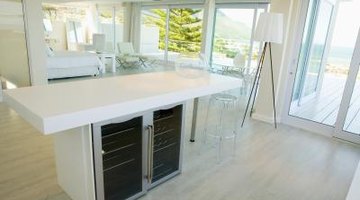What Are Self-Edge Countertops?
A variety of styles and materials can be used to edge laminate countertops, which is what gives laminate countertops an advantage over other countertop materials. The type of edge treatment that you use can make the laminate almost indistinguishable from granite, quartz, or other natural and man-made stone. The “self edge,” also known as the “straight edge” or the “square edge,” is one of the most common laminate edge treatments.
History

The laminate countertop was first introduced in the 1950s and had limited style and color options. The self-edge option was the first edge style introduced. It had a very clean appearance, and it consisted of two pieces of laminate being adhered to the top and the front of a substrate material, typically a piece of particle board or plywood.
Fabrication Method
The self edge is one of the most basic and easiest laminate edges for the manufacturer to fabricate. The fabricator starts off with a deck, which is the countertop itself, in the rough dimensions of the finished countertop. The fabricator spreads glue onto the deck, then applies a strip of laminate to the front edge or nose of the deck. Then the top surface or piece of laminate is put into place. The fabricator uses a roller or mallet to press the laminate onto the deck to ensure good adhesion.
Considerations
Due to the fabrication method of first applying the nose and then the top surface, the self edge of a laminate countertop creates a thin line of exposed core (or deck), known as the “brown line.” This thin brown line can be seen as either a drawback or as an aesthetic detail that can be worked into the design of your countertops.
Another consideration of the self-edge laminate countertop is that the edge is known to peel away or chip off. This is a major concern at the end of a run of countertop where two faces come together to form an outside corner. For this reason, manufacturers provide replacement strips that you can use to replace these peeled-away edges.
Cost
Much of the cost of a laminate countertop comes from the labor. Since the self edge is one of the easiest and most basic laminate edges, it is also one of the cheapest. This cost is dependent on a number of other factors such as the finish of the actual laminate, the installer and the manufacturer, but for a typical 30-foot self-edge laminate countertop that uses a medium-priced laminate finish, you can expect to spend anywhere from $500 to $1,000, including installation (as of May 2011).
References
Resources
Writer Bio
Michelle Deer has a Bachelor of Fine Arts in architecture, a master's degree in architecture and an electronic design minor from the Savannah College of Art and Design. She has spent over five years working in architecture firms writing magazine ads, newspaper ads and designing websites. Deer's articles specialize in home-improvement and other technical topics.
Photo Credits
- Goodshoot/Goodshoot/Getty Images
More Articles



